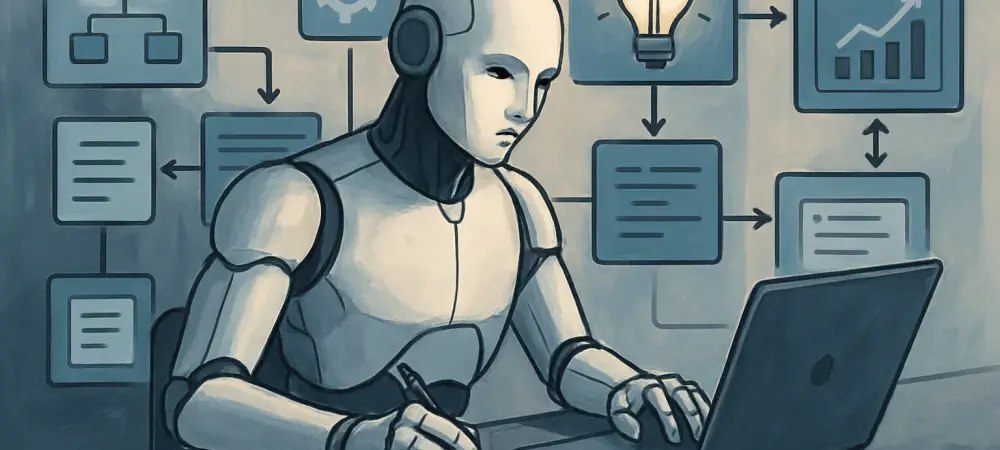Setting the Stage for Autonomous Innovation
In today’s fast-paced business environment, enterprises face an unprecedented challenge: achieving operational efficiency while navigating a landscape of relentless digital transformation. A staggering number of organizations report that manual processes and IT backlogs hinder their ability to innovate swiftly, often stalling critical projects and delaying progress. Enter Agentic AI workflows, a cutting-edge technology that promises to revolutionize how businesses operate by deploying autonomous AI agents to handle tasks with minimal human input. This review delves into the transformative potential of this technology, exploring how it builds on the legacy of low-code/no-code platforms to empower companies with intelligent, self-managing systems.
The significance of Agentic AI lies in its ability to interpret user intent, execute complex workflows, and adapt dynamically to changing conditions. Unlike traditional automation tools, which rely on predefined scripts, this technology introduces a layer of autonomy that reshapes workplace dynamics. By focusing on outcomes rather than processes, it offers a glimpse into a future where human workers are freed from repetitive tasks to focus on strategic growth. This analysis aims to unpack the features, real-world applications, and challenges of this emerging solution.
Diving into the Core Features and Performance
Evolution and Technical Foundations
Agentic AI workflows mark a significant leap from the low-code/no-code platforms that initially democratized technology for non-technical users. Those earlier tools allowed business teams to build applications through visual interfaces, reducing dependency on IT specialists. However, they still required substantial human effort for design and logic setup. In contrast, Agentic AI shifts the paradigm by enabling systems to autonomously plan and execute tasks, learning from data to optimize performance over time.
At the heart of this technology is the ability to integrate seamlessly with existing business infrastructures. Through API-driven compatibility, these AI agents connect effortlessly with CRMs, ERPs, and other enterprise tools, ensuring that adoption does not necessitate a complete overhaul of current systems. This interoperability, combined with the capacity for self-adjustment, positions Agentic AI as a scalable solution for organizations looking to enhance efficiency without disrupting operations.
Real-World Impact and Use Cases
Across industries, Agentic AI is proving its value by tackling inefficiencies in diverse sectors. In healthcare, for instance, autonomous agents streamline patient scheduling and billing processes, cutting down administrative burdens. Finance companies leverage this technology to automate compliance checks and fraud detection, ensuring accuracy while speeding up operations. Meanwhile, in manufacturing, AI-driven workflows optimize supply chain logistics by predicting demand fluctuations and adjusting orders proactively.
The performance of these systems is particularly notable in enhancing customer support functions. By handling routine inquiries and escalating complex issues to human agents, AI workflows improve response times and customer satisfaction. Case studies from leading enterprises reveal a marked increase in operational agility, with some reporting significant reductions in project turnaround times. This adaptability underscores the technology’s potential to address specific pain points while delivering measurable results.
Challenges in Deployment and Scalability
Despite its promise, implementing Agentic AI is not without hurdles. Technical challenges arise in managing complex, non-linear workflows where unexpected variables can disrupt autonomous execution. Ensuring robust adaptability requires continuous refinement of machine learning models, a process that demands substantial resources and expertise. Additionally, integrating these systems into legacy environments can pose compatibility issues, slowing down deployment.
Beyond technical barriers, ethical and regulatory concerns loom large. Transparency in AI decision-making remains a critical issue, particularly for sensitive tasks where accountability is paramount. Businesses must establish clear governance frameworks to maintain human oversight, especially in sectors like healthcare and finance. Market resistance, driven by high initial costs and cultural reluctance to embrace change, further complicates widespread adoption, though ongoing efforts aim to improve affordability and scalability.
Reflecting on the Journey and Looking Ahead
Having explored the capabilities and challenges of Agentic AI workflows, it becomes evident that this technology represents a pivotal shift in business automation. Its ability to deliver speed, scalability, and cognitive relief for human workers stands out as a transformative force in enterprise operations. The seamless integration with existing tools and the tangible benefits observed in various industries highlight its practical value, even as deployment obstacles underscore the need for careful planning.
Looking forward, organizations should prioritize gradual implementation, starting with rule-based tasks to build confidence and measure impact. Establishing robust governance models to balance autonomy with accountability emerges as a crucial next step. Additionally, investing in employee training to foster collaboration with AI agents proves essential for maximizing benefits. As this technology continues to evolve, deeper integration with emerging tools like IoT could unlock even greater potential, paving the way for a more agile and innovative business landscape.

